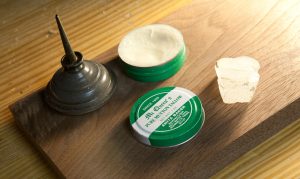We may receive a commission when you use our affiliate links. However, this does not impact our recommendations.
The answer is “no.”
What’s the question? “Doesn’t (oil, tallow, paraffin, beeswax, snake squeezins, earwax, monkey fat) interfere with finishing?”
Still, the answer is “no” – unless you are using some wacky exotic ingredient, or you are rubbing it on like butter.
I know that it’s almost impossible to prove a negative, so permit me to make the following statement: The only workshop liquid or lubricant that has even given me problems with finishing has been glue that I failed to wipe up. I have rubbed my tools with almost every known lubricant on the market, the balm of forbidden trees, oils from the crevices of my body (not kidding), solid waxes. None has ever interfered with finish penetration or adhesion.
So why don’t common workshop lubricants cause trouble? Many of them, such as paraffin, are made from mineral spirits or are easily displaced by mineral spirits. So when a finish, stain or dye with mineral spirits encounters your lubricant, nothing bad happens.
And what if you do use a “bad” lubricant that didn’t mix with your finish? Usually the way you use them prevents them from messing with your finishes. You rub the lubricant on the tool. That’s a thin film. You then rub the tool on the wood. Most of the lubricant ends up on the shavings or in the sawdust. Every time you stroke the tool, the film gets thinner and the amount transferred to the wood get smaller, and almost all of it is cut away by the tool itself.
Wax on the infeed bed of the powered planer is cut away. Lubricant on the plane sole is cut away by the stroke you are making and the next stroke. Tallow on the saw ends up in the sawdust or on a surface that doesn’t get finished (the end grain of a joint surface, for example).

This evening I had some fun with lubricants. I rubbed paraffin, mutton tallow and jojoba oil directly onto some cherry and walnut. I rubbed the lubricant into the grain with great friction. Then I tried finishing it with boiled linseed oil and then varnish. Both were cut with mineral spirits. I could not see any finish penetration problems. They dried just fine.
Then I rubbed the same lubricants on the walnut and cherry and added a dye and pigment stain to the wood. Both blotched (naturally), but I couldn’t see any problems where the lubricants were preventing the dye from coloring the wood.
I know this doesn’t prove anything to anybody but myself. But perhaps someone out there will stop worrying as much about finish penetration and worry more about what can affect finishing – how consistently and carefully you prepare every surface of your project, whether it’s with sandpaper, a scraper or a handplane.
Because it’s not the lubricants that interfere with finishing, it’s usually the finisher….
— Christopher Schwarz
Become a Better Finisher – the Flexner Way
Check out Bob Flexner’s “Understanding Wood Finishing, Revised Edition,” the single best book on the topic. Also, “Flexner on Finishing” has a lot of good finishing information in it. And if you are a beginner, then definitely check out “Finishing 101” – the best basic finishing book I’ve encountered (it’s also by Flexner.)
Here are some supplies and tools we find essential in our everyday work around the shop. We may receive a commission from sales referred by our links; however, we have carefully selected these products for their usefulness and quality.












I realize I’m a little late to the conversation, but the other day I figured I would try using bar soap as a lubricant. I’ve always used it for driving screws so I figured why not. I simply rub a few squiggles of soap on the bottom of the plane, and it glides like a dream. Its something most everybody has readily available, and its quite cheap. I haven’t finished anything after using it yet, but I don’t see why it would be a problem.
Hi Chris,
Where can I buy McQueen’s Pure Mutton Tallow?
I am having a hard time finding it online.
Thanks,
Robert C.
Always operated on that hint to test any finish first on some scrap, if you process the scrap same as you process the build you will see before you start to finish that Chris is correct. Too many boogie men tales, urban legends, and BS in this woodworking stuff. Heck you can douse something with BLO, but get excited about a little oil to keep your tools from rusting, think about it.
Chris do you have an online addy for snake squeezins, I`m almost out, it`s way better than earwax, and Monkeys are such a pain to deal with, they throw stuff at ya.
The *only* thing that ever gave my trouble was a waterborne coating. I suspect that, In Winter, hand lotion caused the headaches I had with the particular coating, in the form of fish eyes. Quit using the hand lotion, and the fish eyes disappeared.
Of course, many people do not consider waterborne coatings for their shop. Using these almost exclusively has eased may of the problems with finishing room design.
With solvent-based coating, never any problems, just like you describe. It literally IS “better living through chemistry”!
Thanks, Chris, for doing the experiments to address this nagging fear. Even though I’ve never had any problems with this, like most woodworkers I still retain a level of fear, usually irrational, with many finishing issues.
To add to your very helpful post, maybe Bob Flexner could do a full article on the issue with more testing and his great explanations.
By the way, silicon is banned from my shop; it just seems unnatural.
Rob
Chris,
Good explanation. We chemists would probably say that the finishes are soluble or miscible (instead of displaced) in each other (non-polar or slightly polar organics soluble in other non-polar organics) with any dilution being negligible, but it all means the same.
And you’re right that silicones and PTFE (Teflon is a Dupont trademark) are completely different creatures (e.g. nobody should have the reagents in their home that are required to dissolve PTFE).
Of course, if the organic can cross-link prior to the finish being applied then solubility becomes an issue, but not on the timescale of your “fun with lubricants” experiment.
Good experiment – great article.
Joe
If you spray a finish and have facial hair you should not use a respirator, it will NOT seal. As a person who had to take respirator training once a year at my job, we learned that if you have facial hair the only respirator that you could use was a Bullard (spelling?) hood. IF you have facial hair wearing a respirator will not protect you at all.
As Roy Underhill says in “Working Wood With Wedge and Edge” (I don’t have the text with me, so I’m paraphrasing here) – ‘Of course, if you don’t use a lubricant the wood might be too sweat-stained to take a finish anyway’.
“This evening I had some fun with lubricants.”
Priceless.
…time to break out the monkey fat!!
Can one conclude that taking care to use dewaxed shellac as a sealing coat for your finishing regimen is also something that we don’t have to worry about, either?
I really appreciate this entry. Too often we get caught up in an important fact (contaminates) but forget the most important shop tool, common sense. Of course the lubricant is not going to be a permanent fixture on your plane, as you have to reapply it often while using your plane. That is, unless your plane has a base made of wax!
Also, you should remove the “usually” from the last sentence…
I think it would be best to avoid silicone- and teflon-based lubricants.
Also, the rub-with-lubricant-then-finish trick might not end so happily if you’re using water-based finishes.
-Steve